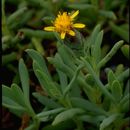Description
provided by eFloras
Leaf blades 15–35+ mm. Phyllaries often purplish. Ray laminae 1–3+ mm. Disc corollas 6–7 mm. Cypselae 2–3 mm. 2n = 38.
- license
- cc-by-nc-sa-3.0
- copyright
- Missouri Botanical Garden, 4344 Shaw Boulevard, St. Louis, MO, 63110 USA
Synonym
provided by eFloras
Coinogyne carnosa Lessing, Linnaea 6: 520. 1831
- license
- cc-by-nc-sa-3.0
- copyright
- Missouri Botanical Garden, 4344 Shaw Boulevard, St. Louis, MO, 63110 USA
Brief Summary
provided by EOL authors
Jaumea carnosa has a bioregional distribution ranging from British Columbia, south to Washington, Oregon, California and northern Baja California. All the distribution is coastal, including salt marshes, bases of sea cliffs and estuary verges. Elevation of all occurrences is from sea level to five meters.
Also known by the common name Marsh jaumea, this salt tolerant plant has long weak stems. The fleshy leaves are typically 15 to 50 millimeters long, and are linear to narrowly oblong-oblanceolate in shape. Inflorescence heads are radiate and measure 12 to 20 millimeters across.
Comprehensive Description
provided by North American Flora
Coinogyne carnosa Less. Linnaea 6: 521. 1831
Jaumea carnosa A. Gray, in Torr. U. S. Expl. Exp. 17: 360. 1874.
A perennial, with a creeping rootstock; stem procumbent or ascending, glabrous, striate;
leaves fleshy, decussately opposite, linear-oblanceolate, 2-4 cm. long, 2-5 mm. wide, sessile,
connate at the base; involucre about 1.5 cm. high and 1 cm. broad; bracts oval, rounded
at the apex, successively shorter; ligules yellow, 6-7 mm. long. 1 mm. wide; achenes oblong,
3 mm. long.
Type locality: California.
Distribution: Ocean beaches from Puget Sound, Washington, to San Diego, California.
- bibliographic citation
- Per Axel Rydberg. 1914. (CARDUALES); CARDUACEAE; HELENIEAE. North American flora. vol 34(1). New York Botanical Garden, New York, NY
Jaumea carnosa: Brief Summary
provided by wikipedia EN
Jaumea carnosa, known by the common names marsh jaumea, fleshy jaumea, or simply jaumea, is a halophytic salt marsh plant native to the wetlands, coastal sea cliffs and salt marshes of the western coast of North America.
- license
- cc-by-sa-3.0
- copyright
- Wikipedia authors and editors

